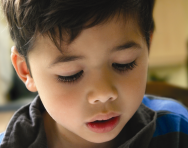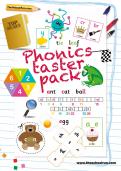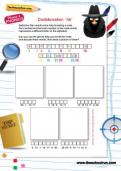Oxford Reading Tree Stage 2 Reading Level Compared to Reading Recovery Level
School reading schemes explained

Enquire whatever parent of a Reception child about Biff, Flake and Kipper, and they'll know exactly who yous're talking near. But just how do primary school reading schemes work, and how can you tell if your child is progressing at the right rate? Lucy Dimbylow puts these questions to the teachers who utilize reading schemes in the classroom.
Which reading schemes are commonly used in schools?
Chief schools accept a range of reading schemes to cull from. The nearly popular include Oxford Reading Tree (ORT), Collins Large Cat and Rigby Star, but other schemes are also used, including Lighthouse, Storyworlds and New Reading 360. Some schools proceed to employ older series, such as Ginn and New Way.


Download a FREE phonics pack
- Phonics phases sound mats
- five phonics games
- Plus access hundreds more phonics worksheets when y'all register for Gratuitous
At Rickleton Main School in Sunderland, children follow the ORT programme. "The books are new, bright and fresh, and the stories are nigh events that children can relate to," explains literacy coordinator Nicola Simpson. Meanwhile, at Headley Park Primary School, Bristol, teachers apply the Success For All scheme in class – a programme based around proper children'south books – and Collins Big True cat equally take-dwelling house books. "Success For All gives a good foundation in phonics, while the Big True cat books are a lot more inspiring than the onetime, tatty dwelling readers that they were called to replace," says deputy head Tim Browse.
"It's common for schools to use a combination of reading schemes," says Sophie Quarterman, ORT's marketing managing director. "Some follow the system rigidly, only others mix and match, using ane or more schemes."
How are the schemes devised?
Reading schemes are developed in conjunction with literacy experts. ORT, for example, is supported by Debbie Hepplewhite, creator of the synthetic phonics plan used in schools. Most schemes brainstorm in the Foundation Stage and progressively become more difficult. 'For example, Key Stage 1 books are written with a mix of loftier-frequency and decodable words to develop a range of reading strategies, while Key Stage 2 books cover a wide range of genres and subjects, linking to the curriculum,' explains Louisa Combs, marketing executive for Collins Large Cat.
How many books do children read at each stage?
The number of books at each level depends on how much do children need at that stage.
Many schemes also have offshoots alongside the core texts. "In addition to the classic Biff, Scrap and Kipper texts, ORT offers other strands, such every bit Songbirds Phonics, Snapdragon variety fiction, and Fireflies non-fiction, to develop children'south reading range," says Sophie Quarterman.
What exercise the different levels mean?
Children learn to read at their own pace, but every bit a guide, the almost popular reading schemes are broken downwardly as follows:
Oxford Reading Tree
| Stage 1 | 3.v to iv.v years |
| Stage i+ | 4.five to 5 years |
| Phase ii | four.5 to 5 years |
| Stage 3 | five to 5.5 years |
| Stage iv | v to 5.five years |
| Phase 5 | five.5 to 6 years |
| Phase half-dozen | six to six.5 years |
| Stage 7 | vi.5 to 7 years |
| Stage 8 | seven to 7.v years |
| Stage 9 | 7.5 to viii years |
Collins Big True cat, Rigby Star and Lighthouse
Reception: lilac, pink A/B, red A/B
Year one: yellowish, blue, light-green
Year two: orange, turquoise, purple, gilded, white, lime
What other resources are available?
Most schemes have additional resources that support their cadre texts. ORT's add together-ons include CD-ROMs, talking stories, puppets, stickers, comprehension sheets and software, with free eBooks and Biff, Bit and Kipper games.
Collins Big Cat too offers a selection of apps.
Do all schools utilise reading schemes?
No – Highgate Primary Schoolhouse in London is one such school. 'We apply existent books, equally nosotros find them more stimulating,' explains Headteacher William Dean. "If children learn to savor books, their reading ability will follow."
How can y'all help if your child is lagging behind?
"Children learn to read at unlike rates, so information technology shouldn't become competitive," says William Dean. "If your kid is struggling, don't push him to read, but proceed reading to him, and talk about what you lot read. This will help him to become inquisitive about books and desire to read for himself."
"One good strategy is to have the focus off reading aloud," adds Tim Browse. "Instead, allow him read a page to himself, and so ask him questions near it. When children are learning to read, information technology's difficult for them to accept in the message of the story if all their attention is on reading aloud."
How will your child brand the transition to normal books?
Many schools permit children to become 'free readers' and choose their own books once they terminate the reading scheme. Others apply a combination of readers and normal books throughout, for instance by sending dwelling house one reader and one normal book to read together. "Ideally, though, there shouldn't be a transition," says William Dean. "Even where schools utilise reading schemes, children should be enjoying normal books aslope, at schoolhouse and at home. Reading loftier-quality books is the best way to encourage a love of reading."
Notice out more most what children acquire in Cardinal phase 1 English to sympathize what they'll be taught in reading, writing, and speaking and listening.
Source: https://www.theschoolrun.com/school-reading-schemes-explained
0 Response to "Oxford Reading Tree Stage 2 Reading Level Compared to Reading Recovery Level"
Post a Comment